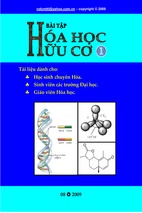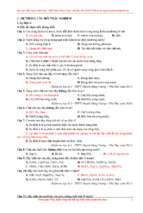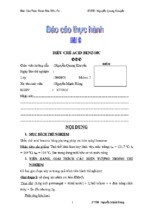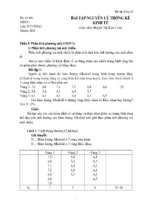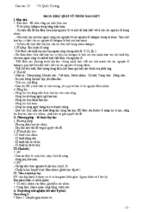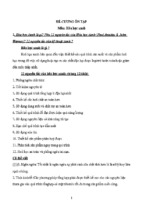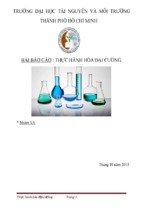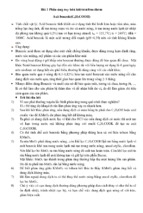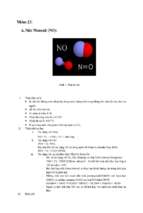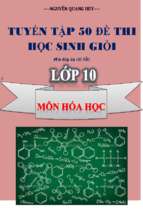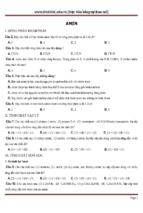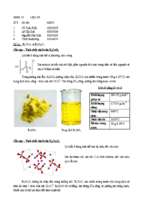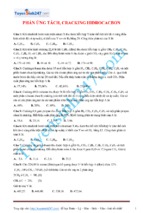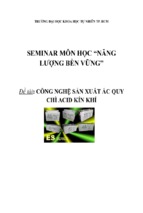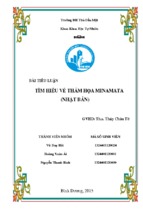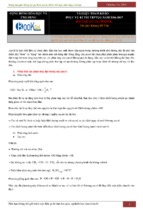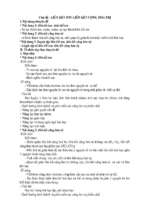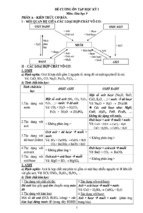Introduction to Chemical Engineering Kinetics and Reactor Design, Second Edition - Charles G. Hill, Thatcher W. Root
Introduction to Chemical
Engineering Kinetics and
Reactor Design
Introduction to Chemical
Engineering Kinetics and
Reactor Design
Second Edition
Charles G. Hill, Jr.
Thatcher W. Root
Professors of Chemical and Biological Engineering
University of Wisconsin – Madison
Copyright © 2014 by John Wiley & Sons, Inc. All rights reserved.
Published by John Wiley & Sons, Inc., Hoboken, New Jersey.
Published simultaneously in Canada.
No part of this publication may be reproduced, stored in a retrieval system, or transmitted in any form or by
any means, electronic, mechanical, photocopying, recording, scanning, or otherwise, except as permitted
under Section 107 or 108 of the 1976 United States Copyright Act, without either the prior written
permission of the Publisher, or authorization through payment of the appropriate per-copy fee to the
Copyright Clearance Center, Inc., 222 Rosewood Drive, Danvers, MA 01923, (978) 750-8400, fax (978)
750-4470, or on the web at www.copyright.com. Requests to the Publisher for permission should be
addressed to the Permissions Department, John Wiley & Sons, Inc., 111 River Street, Hoboken, NJ 07030,
(201) 748-6011, fax (201) 748-6008, or online at http://www.wiley.com/go/permission.
Limit of Liability/Disclaimer of Warranty: While the publisher and author have used their best efforts in
preparing this book, they make no representations or warranties with respect to the accuracy or completeness
of the contents of this book and specifically disclaim any implied warranties of merchantability or fitness for
a particular purpose. No warranty may be created or extended by sales representatives or written sales
materials. The advice and strategies contained herein may not be suitable for your situation. You should
consult with a professional where appropriate. Neither the publisher nor author shall be liable for any loss of
profit or any other commercial damages, including but not limited to special, incidental, consequential, or
other damages.
For general information on our other products and services or for technical support, please contact our
Customer Care Department within the United States at (800) 762-2974, outside the United States at (317)
572-3993 or fax (317) 572-4002.
Wiley also publishes its books in a variety of electronic formats. Some content that appears in print may not
be available in electronic formats. For more information about Wiley products, visit our web site at
www.wiley.com.
Library of Congress Cataloging-in-Publication Data:
Hill, Charles G., 1937–
Introduction to chemical engineering kinetics & reactor design / Charles G. Hill, Jr.,
Thatcher W. Root, professors of chemical and biological engineering, University of Wisconsin,
Madison. – Second edition.
pages cm
Includes bibliographical references and index.
ISBN 978-1-118-36825-1 (cloth)
1. Chemical kinetics. 2. Chemical reactors–Design and construction. I. Root, Thatcher W.
1957- II. Title. III. Title: Introduction to chemical engineering kinetics and reactor design.
QD502.H54 2014
660′ .2832–dc23
2013023526
Printed in the United States of America
10 9 8 7 6 5 4 3 2 1
Contents
Preface
3.1
ix
Preface to the First Edition
xi
1. Stoichiometric Coefficients and Reaction
Progress Variables
1.0 Introduction
1
1.1 Basic Stoichiometric Concepts
Literature Citation
3
2. Thermodynamics of Chemical Reactions
1
2
4
2.0 Introduction
4
2.1 Chemical Potentials and Standard States
4
2.2 Energy Effects Associated with Chemical
Reactions
5
2.3 Sources of Thermochemical Data
7
2.4 The Equilibrium Constant and its Relation
7
to ΔG0
2.5 Effects of Temperature and Pressure Changes
8
on the Equilibrium Constant
2.6 Determination of Equilibrium
9
Compositions
2.7 Effects of Reaction Conditions on Equilibrium
11
Yields
2.8 Heterogeneous Reactions
12
2.9 Equilibrium Treatment of Simultaneous
12
Reactions
2.10 Supplementary Reading References
15
Literature Citations
15
Problems
15
3. Basic Concepts in Chemical Kinetics:
Determination of the Reaction Rate
Expression
3.0 Introduction
22
Mathematical Characterization of Simple
Reaction Systems
25
3.2 Experimental Aspects of Kinetic
29
Studies
3.3 Techniques for the Interpretation of Kinetic
34
Data
Literature Citations
53
Problems
54
4. Basic Concepts in Chemical Kinetics:
Molecular Interpretations of Kinetic
Phenomena
4.0 Introduction
72
4.1 Reaction Mechanisms
73
4.2 Chain Reactions
83
4.3 Molecular Theories of Chemical
93
Kinetics
Literature Citations
103
Problems
104
5. Chemical Systems Involving Multiple
Reactions
117
5.0
5.1
5.2
5.3
Introduction
117
Reversible Reactions
117
Parallel or Competitive Reactions
125
Series or Consecutive Reactions: Irreversible
Series Reactions
133
5.4 Complex Reactions
137
Literature Citations
142
Problems
142
6. Elements of Heterogeneous Catalysis
22
72
6.0 Introduction
152
6.1 Adsorption Phenomena
6.2 Adsorption Isotherms
152
153
156
v
vi
Contents
6.3 Reaction Rate Expressions for Heterogeneous
Catalytic Reactions
160
6.4 Physical Characterization of Heterogeneous
Catalysts
170
6.5 Catalyst Preparation, Fabrication, and
174
Activation
6.6 Poisoning and Deactivation of
177
Catalysts
Literature Citations
178
Problems
179
7. Liquid Phase Reactions
189
7.0 Introduction
189
7.1 Electrostatic Effects in Liquid
191
Solution
7.2 Pressure Effects on Reactions in Liquid
192
Solution
7.3 Homogeneous Catalysis in Liquid
193
Solution
7.4 Correlation Methods for Kinetic Data: Linear
Free Energy Relations
202
Literature Citations
207
Problems
207
8. Basic Concepts in Reactor Design and Ideal
Reactor Models
216
8.0
8.1
8.2
8.3
Introduction
216
Design Analysis for Batch Reactors
225
Design of Tubular Reactors
228
Continuous Flow Stirred-Tank
234
Reactors
8.4 Reactor Networks Composed of Combinations
of Ideal Continuous Flow Stirred-Tank
254
Reactors and Plug Flow Reactors
8.5 Summary of Fundamental Design Relations:
Comparison of Isothermal Stirred-Tank and
Plug Flow Reactors
256
8.6 Semibatch or Semiflow Reactors
256
Literature Citations
259
Problems
259
9. Selectivity and Optimization Considerations
in the Design of Isothermal Reactors
9.0 Introduction
273
9.1 Competitive (Parallel) Reactions
9.2 Consecutive (Series) Reactions:
k1
k2
273
274
k3
278
A −→ B −→ C −→ D
9.3 Competitive Consecutive Reactions
283
9.4 Reactor Design for Autocatalytic
Reactions
290
Literature Citations
294
Problems
294
10. Temperature and Energy Effects in Chemical
Reactors
305
10.0 Introduction
305
10.1 The Energy Balance as Applied to Chemical
305
Reactors
10.2 The Ideal Well-Stirred Batch Reactor
307
10.3 The Ideal Continuous Flow Stirred-Tank
Reactor
311
10.4 Temperature and Energy Considerations
in Tubular Reactors
314
10.5 Autothermal Operation of Reactors
317
10.6 Stable Operating Conditions in Stirred Tank
Reactors
320
10.7 Selection of Optimum Reactor Temperature
Profiles: Thermodynamic and Selectivity
324
Considerations
Literature Citations
327
Problems
328
11. Deviations from Ideal Flow Conditions
337
11.0 Introduction
337
11.1 Residence Time Distribution Functions, F(t)
337
and dF(t)
11.2 Conversion Levels in Nonideal Flow
352
Reactors
11.3 General Comments and Rules
358
of Thumb
Literature Citations
359
Problems
359
12. Reactor Design for Heterogeneous Catalytic
Reactions
12.0 Introduction
371
12.1 Commercially Significant Types of
Heterogeneous Catalytic Reactors
371
12.2 Mass Transport Processes within Porous
Catalysts
376
12.3 Diffusion and Reaction in Porous
Catalysts
380
12.4 Mass Transfer Between the Bulk Fluid
and External Surfaces of Solid
Catalysts
406
371
Contents
12.5
12.6
12.7
12.8
Heat Transfer Between the Bulk Fluid and
External Surfaces of Solid Catalysts
413
Global Reaction Rates
416
Design of Fixed Bed Reactors
418
Design of Fluidized Bed Catalytic
437
Reactors
Literature Citations
439
Problems
441
13. Basic and Applied Aspects of Biochemical
Transformations and Bioreactors
13.0
13.1
13.2
Introduction
451
Growth Cycles of Microorganisms: Batch
Operation of Bioreactors
452
Principles and Special Considerations for
Bioreactor Design
472
vii
13.3 Commercial Scale Applications of Bioreactors
in Chemical and Environmental
495
Engineering
Literature Citations
516
Problems
517
Appendix A. Fugacity Coefficient Chart
527
Appendix B. Nomenclature
528
Appendix C. Supplementary References
535
451
Author Index
537
Subject Index
545
Preface
More
than three decades have elapsed since the
publication of the first edition of this book in 1977.
Although the basic principles on which the exposition
in the body of the text is based remain unchanged, there
have been noteworthy advances in the tools employed by
practicing engineers in solving problems associated with
the design of chemical reactors. Some of these tools need
to be present in the knowledge base of chemical engineers
engaged in studies of the principles of chemical kinetics
and reactor design—the need for preparation of a second
edition is thus evident. It has been primarily the pressure
of other professional responsibilities, rather than a lack
of interest on the part of the principal author, which has
been responsible for the time elapsed between editions.
Only since Professor Hill’s retirement was precipitated by
complications from surgery have sufficiently large blocks
of time become available to permit a concerted effort to
prepare the manuscript for the second edition.
Both the major thrust of the book as an introductory
textbook focusing on chemical kinetics and reactor design,
and the pedagogical approach involving applications of
the laws of conservation of mass and energy to increasingly difficult situations remain at heart the same as the
exposition in the first edition. The major changes in the
second edition involve a multitude of new problems based
on articles in the relevant literature that are designed to
provide stimulating challenges to the development of a
solid understanding of this material. Both students and
instructors will benefit from scrutiny of the problems with
a view to determining which problems are most germane
to developing the problem-solving skills of the students in
those areas that are most relevant to the particular topics
emphasized by the instructor. Practicing engineers engaged
in self study will also find the large array of problems
useful in assessing their own command of the particular
topic areas of immediate interest. We believe that it is only
when one can apply to challenging new situations the basic
principles in an area that he or she has been studying that
one truly comprehends the subject matter. Hence one of
the distinctive features of both the first and second editions
is the inclusion of a large number of practical problems
encompassing a wide range of situations featuring actual
chemical compounds and interpretation of actual data from
the literature, rather than problems involving nebulous
species A, B, C, and so on, and hypothetical rate constants which are commonly found in most undergraduate
textbooks. Roughly 75% of the problems are new, and
these new problems were often designed to take advantage
of advances in both the relevant computer software (i.e.,
spreadsheets, equation solvers, MathCad, Matlab, etc.)
and the degree of computer literacy expected of students
matriculating in chemical engineering programs. We
believe that regardless of whether the reader is a student,
a teaching assistant or instructor, or a practicing engineer,
he or she will find many of the problems in the text to
be both intellectually challenging and excellent vehicles
for sharpening one’s professional skills in the areas of
chemical kinetics, catalysis, and chemical reactor design.
Even though the International System of units (SI) is
used extensively in the text and the associated problems,
we do not apologize for the fact that we do not employ this
system of units to the exclusion of others. One powerful
tool that chemical engineers have employed for more than a
century is the use of empirical correlations of data obtained
from equipment carrying out one or more traditional unit
operation(s). Often these empirical correlations are based
on dimensional analysis of the process and involve use of
physical properties, thermochemical properties, transport
properties, transfer coefficients, and so on, that may or may
not be readily available from the literature in SI units. The
ability of practicing chemical engineers to make the necessary conversion of units correctly has long been a hallmark
of the profession. Especially in the area of chemical kinetics
and heterogeneous catalytic reactor design, students must
be able to convert units properly to be successful in their
efforts to utilize these empirical correlations.
ix
x
Preface
The senior author has always enjoyed teaching the
undergraduate course in chemical kinetics and reactor design and has regarded the positive feedback he
received from students during his 40+ years as a teacher
of this subject as a generous return on investments of
his time preparing new problems, giving and updating
lectures, counseling individual students, and preparing
the manuscripts for both the first and second editions of
this book. It is always a pleasure to learn of the successes
achieved by former students, both undergraduate and
graduate. Although individual students are responsible for
the efforts leading to their own success, I have been pleased
to note that five students who were in my undergraduate
course in kinetics have gone on to base their research
careers in kinetics and catalysis at leading departments of
chemical engineering and have served as chairs of said
departments. At least I did nothing to turn off their interest
in this aspect of chemical engineering.
This preface would be incomplete if I did not acknowledge the invaluable contributions of some 30 to 40 teaching assistants and undergraduate paper graders who worked
with me in teaching this course. They often pointed out
ambiguities in problem statements, missing data, or other
difficulties associated with individual problem statements. I
am grateful for their contributions but am reluctant to name
them for fear of not properly acknowledging others whose
contributions occurred decades ago.
We also need to acknowledge the invaluable assistance
of several members of the department staff in providing
assistance when problems with computers exceeded
our abilities to diagnose and correct computer related
difficulties. Todd Ninman and Mary Heimbecker were
particularly helpful in this respect. Many undergraduates
addressed Professor Hill’s needs for help in generating
accurate versions of the numerous equations in the book.
They removed one of the major impediments to generating
enthusiasm for the Sisyphean task of reducing ideas to a
finished manuscript. At various points along the path to
a finished manuscript we sought and received assistance
from our colleagues on the UW faculty and staff, both
inside and outside the department. The occasions were
numerous and we much appreciate their cooperation.
During the final stages of preparing the manuscript for
the second edition, Jody Hoesly of the University of
Wisconsin’s Wendt Engineering Library was an wonderful
resource in helping Professor Hill to locate and chase
down the holders of the copyrights or viable alternatives
for materials appearing in the first edition that were also
needed in the second edition. She was an invaluable guide
in helping us fulfill our responsibilities under copyright
law.
Professor Hill also wishes to acknowledge the inspiration of the late Professor Robert C. Reid of MIT as a
role model for how a faculty member should interact with
students and research assistants. He is also grateful for the
technique that Bob taught him of requiring participants
in a course to read an article in the relevant literature and
to prepare a problem (with the associated solution) based
on an article that applies to material learned in this class.
Typically, the assignment was made in the last week or
two of the course. Professor Hill has used this assignment
for decades as a vehicle for both demonstrating to students
not only how much they have learned in the class as
they prepare for the final exam, but also that they can
read and comprehend much of the literature focusing on
kinetics and reactor design. Often, the problems posed by
students are trivial or impossibly difficult, but the benefit
for the instructor is that the students identify for future
generations of students not only interesting articles, but
articles that are sufficiently relevant to the course that they
may merit review with the idea that a senior instructor may
use the article as the basis for challenging and stimulating problems at an appropriate pedagogical level. Such
problems form the basis for many of the problems in the
text that utilize techniques or data taken directly from the
literature.
Professor Root is pleased to help rejuvenate this book
for use by future classes of students seeking to improve their
knowledge and understanding of this very important aspect
of chemical engineering. Professor Hill hopes that readers
enjoy the subject area as much as he has in more than four
decades of studying and teaching this material.
Madison, Wisconsin
June 1, 2013
Charles G. Hill, Jr.
Thatcher W. Root
Preface to the First Edition
One feature that distinguishes the education of the chemical engineer from that of other engineers is an exposure
to the basic concepts of chemical reaction kinetics and
chemical reactor design. This textbook provides a judicious
introductory level overview of these subjects. Emphasis is
placed on the aspects of chemical kinetics and material and
energy balances that form the foundation for the practice
of reactor design.
The text is designed as a teaching instrument. It can be
used to introduce the novice to chemical kinetics and reactor design and to guide him/her until he/she understands
the fundamentals well enough to read both articles in the
literature and more advanced texts with understanding.
Because the chemical engineer who practices reactor
design must have more than a nodding acquaintance with
the chemical aspects of reaction kinetics, a significant
portion of this textbook is devoted to this subject. The
modern chemical process industry, which has played a
significant role in the development of our technology-based
society, has evolved because the engineer has been able to
commercialize the laboratory discoveries of the scientist.
To carry out the necessary scale-up procedures safely
and economically, the reactor designer must have a sound
knowledge of the chemistry involved. Modern introductory
courses in physical chemistry usually do not provide the
breadth or the in-depth treatment of reaction kinetics that
is required by the chemical engineer who is faced with a
reactor design problem. More advanced courses in kinetics
that are taught by physical chemists naturally reflect the
research interests of the individuals involved; they do not
stress the transmittal of that information which is most
useful to individuals engaged in the practice of reactor
design. Seldom is significant attention paid to the subject
of heterogeneous catalysis and to the key role that catalytic
processes play in the industrial world.
Chapters 3 to 7 treat the aspects of chemical kinetics
that are important to the education of a well-read chemical
engineer. To stress further the chemical problems involved
and to provide links to the real world, I have attempted
where possible to use actual chemical reactions and kinetic
parameters in the many illustrative examples and problems.
However, to retain as much generality as possible, the presentations of basic concepts and the derivations of fundamental equations are couched in terms of the anonymous
chemical species A, B, C, U, V, etc. Where it is appropriate, the specific chemical reactions used in the illustrations
are reformulated in these terms to indicate the manner in
which the generalized relations are employed.
Chapters 8 to 12 provide an introduction to chemical
reactor design. We start with the concept of idealized
reactors with specified mixing characteristics operating
isothermally and then introduce complications such as the
use of combinations of reactors, implications of multiple
reactions, temperature and energy effects, residence time
effects, and heat and mass transfer limitations that are
often involved when heterogeneous catalysts are employed.
Emphasis is placed on the fact that chemical reactor design
represents a straightforward application of the bread and
butter tools of the chemical engineer - the material balance
and the energy balance. The fundamental design equations
in the second half of the text are algebraic descendents of
the generalized material balance equation
rate of input = rate of output + rate of accumulation
+ rate of disappearance by reaction (P.1)
In the case of nonisothermal systems one must write
equations of this form for both for energy and for the
chemical species of interest, and then solve the resultant
equations simultaneously to characterize the effluent composition and the thermal effects associated with operation
of the reactor. Although the material and energy balance
equations are not coupled when no temperature changes
occur in the reactor, the design engineer still must solve the
energy balance equation to ensure that sufficient capacity
for energy transfer is provided so that the reactor will
xi
xii
Preface to the First Edition
indeed operate isothermally. The text stresses that the
design process merely involves an extension of concepts
learned previously. The application of these concepts in the
design process involves equations that differ somewhat in
mathematical form from the algebraic equations normally
encountered in the introductory material and energy balance course, but the underlying principles are unchanged.
The illustrations involved in the reactor design portion of
the text are again based where possible on real chemical
examples and actual kinetic data. I believe that the basic
concepts underlying the subject of chemical kinetics and
reactor design as developed in this text may readily be
rephrased or applied in computer language. However, my
pedagogical preference is to present material relevant to
computer-aided reactor design only after the students have
been thoroughly exposed to the fundamental concepts of
this subject and mastered their use in attacking simple
reactor design problems. I believe that full exposure to
the subject of computer-aided reactor design should be
deferred to intermediate courses in reactor design (and to
more advanced texts), but this text focuses on providing
a rational foundation for such courses while deliberately
avoiding any discussion of the (forever-evolving) details
of the software currently used to solve problems of interest
in computer-aided design.
The notes that form the basis for the bulk of this textbook have been used for several years in the undergraduate
course in chemical kinetics and reactor design at the University of Wisconsin. In this course, emphasis is placed on
Chapters 3 to 6 and 8 to 12, omitting detailed class discussions of many of the mathematical derivations. My colleagues and I stress the necessity for developing a "seat of
the pants" feeling for the phenomena involved as well as
an ability to analyze quantitative problems in terms of the
design framework developed in the text.
The material on catalysis and heterogeneous reactions in Chapters 6 and 12 is a useful framework for an
intermediate level course in catalysis and chemical reactor
design. In such a course emphasis is placed on developing
the student’s ability to critically analyze actual kinetic data
obtained from the literature in order to acquaint him/her
with many of the traps into which the unwary may fall.
Some of the problems in Chapter 12 have evolved from a
course of this type.
Most of the illustrative examples and problems in the
text are based on actual data from the kinetics literature.
However, in many cases, rate constants, heats of reaction,
activation energies, and other parameters have been converted to SI units from various other systems. To be able to
utilize the vast literature of kinetics for reactor design purposes, one must develop a facility for making appropriate
transformations of parameters from one system of units to
another. Consequently, I have chosen not to employ SI units
exclusively in this text.
Like other authors of textbooks for undergraduates, I
owe major debts to the instructors who first introduced me
to this subject matter and to the authors and researchers
whose publications have contributed to my understanding
of the subject. As a student, I benefited from instruction by
R. C. Reid, C. N. Satterfield, and I. Amdur and from exposure to the texts of Walas, Frost and Pearson, and Benson.
Some of the material in Chapter 6 has been adapted with
permission from the course notes of Professor C. N. Satterfield of MIT, whose direct and indirect influence on my
thinking is further evident in some of the data interpretation problems in Chapters 6 and 12. As an instructor I have
found the texts by Levenspiel and Smith to be particularly
useful at the undergraduate level; the books by Denbigh,
Laidler, Hinshelwood, Aris, and Kramers and Westerterp
have also helped to shape my views of chemical kinetics
and reactor design. I have tried to use the best ideas of
these individuals and the approaches that I have found particularly useful in the classroom in the synthesis of this
textbook. A major attraction of this subject is that there are
many alternative ways of viewing the subject. Without an
exposure to several viewpoints, one cannot begin to grasp
the subject in its entirety. Only after such exposure, bombardment by the probing questions of one’s students, and
much contemplation can one begin to synthesize an individual philosophy of kinetics. To the humanist it may seem
a misnomer to talk in terms of a philosophical approach
to kinetics, but to the individuals who have taken kinetics
courses at different schools or even in different departments
and to the individuals who have read widely in the kinetics
literature, it is evident that several such approaches do exist
and that specialists in the area do have individual philosophies that characterize their approach to the subject.
The stimulating environment provided by the students
and staff of the Chemical Engineering Department at the
University of Wisconsin has provided much of the necessary encouragement and motivation for writing this textbook. The Department has long been a fertile environment
for research and textbook writing in the area of chemical
kinetics and reactor design. The text by O. A. Hougen and
K. M. Watson represents a classic pioneering effort to establish a rational approach to the subject from the viewpoint of
the chemical engineer. Through the years these individuals
and several members of our current staff have contributed
significantly to the evolution of the subject. I am indebted
to my colleagues, W. E. Stewart, S. H. Langer, C. C. Watson, R. A. Grieger, S. L. Cooper, and T. W. Chapman, who
have used earlier versions of this textbook as class notes or
commented thereon, to my benefit. All errors are, of course,
my own responsibility.
I am grateful to the graduate students who have served
as my teaching assistants and who have brought to my attention various ambiguities in the text or problem statements.
Preface to the First Edition
These include J. F. Welch, A. Yu, R. Krug, E. Guertin, A.
Kozinski, G. Estes, J. Coca, R. Safford, R. Harrison, J. Yurchak, G. Schrader, A. Parker, T. Kumar, and A. Spence. I
also thank the students on whom I have tried out my ideas.
Their response to the subject matter has provided much of
the motivation for this textbook.
Since drafts of this text were used as course notes,
the secretarial staff of the department, which includes D.
Peterson, C. Sherven, M. Sullivan, and M. Carr, deserves
my warmest thanks for typing this material. I am also very
xiii
appreciative of my (former) wife’s efforts in typing the
final draft of this manuscript and in correcting the galley
proofs. Vivian Kehane, Jacqueline Lachmann, and Peter
Klein of Wiley were particularly helpful in transforming
my manuscript into this text.
My (former) wife and my children were at times
neglected during the preparation of this book; for their
cooperation and inspiration I am particularly grateful.
Madison, Wisconsin
Charles G. Hill, Jr.
Chapter
1
Stoichiometric Coefficients and
Reaction Progress Variables
1.0
INTRODUCTION
In the absence of chemical reactions, Earth would be a
barren planet. No life of any sort would exist. Even if we
were to exempt the fundamental reactions involved in life
processes from our proscription on chemical reactions,
our lives would be extremely different from what they are
today. There would be no fire for warmth and cooking,
no iron and steel with which to fashion even the crudest
implements, no synthetic fibers for making clothing or
bedding, no combustion engines to power our vehicles, and
no pharmaceutical products to treat our health problems.
One feature that distinguishes the chemical engineer
from other types of engineers is the ability to analyze
systems in which chemical reactions are occurring and to
apply the results of his or her analysis in a manner that
benefits society. Consequently, chemical engineers must
be well acquainted with the fundamentals of chemical
reaction kinetics and the manner in which they are applied
in reactor design. In this book we provide a systematic
introduction to these subjects. Three fundamental types of
equations are employed in the development of the subject:
material balances, energy balances, and rate expressions.
Chemical kinetics is the branch of physical chemistry
that deals with quantitative studies of the rates at which
chemical processes occur, the factors on which these
rates depend, and the molecular acts involved in reaction
processes. A description of a reaction in terms of its
constituent molecular acts is known as the mechanism of
the reaction. Physical and organic chemists are interested
in chemical kinetics primarily for the light that it sheds on
molecular properties. From interpretations of macroscopic
kinetic data in terms of molecular mechanisms, they
can gain insight into the nature of reacting systems, the
processes by which chemical bonds are made and broken,
and the structure of the resulting product. Although chemical engineers find the concept of a reaction mechanism
useful in the correlation, interpolation, and extrapolation
of rate data, they are more concerned with applications
of chemical kinetics in the development of profitable
manufacturing processes.
Chemical engineers have traditionally approached
kinetics studies with the goal of describing the behavior of
reacting systems in terms of macroscopically observable
quantities such as temperature, pressure, composition, and
Reynolds number. This empirical approach has been very
fruitful in that it has permitted chemical reactor technology
to develop to the point that it can be employed in the
manufacture of an amazing array of products that enhance
our quality of life.
The dynamic viewpoint of chemical kinetics focuses
on variations in chemical composition with either time in
a batch reactor or position in a continuous flow reactor.
This situation may be contrasted with the essentially static
perspective of thermodynamics. A kinetic system is a
system in which there is unidirectional movement toward
thermodynamic equilibrium. The chemical composition of
a closed system in which a reaction is occurring evolves
as time elapses. A system that is in thermodynamic equilibrium, on the other hand, undergoes no net change with
time. The thermodynamicist is interested only in the initial
and final states of the system and is not concerned with the
time required for the transition or the molecular processes
involved therein; the chemical kineticist is concerned
primarily with these issues.
In principle, one can treat the thermodynamics of
chemical reactions on a kinetic basis by recognizing that
the equilibrium condition corresponds to the situation in
which the rates of the forward and reverse reactions are
identical. In this sense kinetics is the more fundamental
science. Nonetheless, thermodynamics provides much vital
information to the kineticist and to the reactor designer.
In particular, the first step in determining the economic
feasibility of producing a given material from a specified
Introduction to Chemical Engineering Kinetics and Reactor Design, Second Edition. Charles G. Hill, Jr. and Thatcher W. Root.
© 2014 John Wiley & Sons, Inc. Published 2014 by John Wiley & Sons, Inc.
1
2
Chapter 1
Stoichiometric Coefficients and Reaction Progress Variables
feedstock should be a determination of the product yield
at equilibrium at the conditions of the reactor outlet. Since
this composition represents the goal toward which the
kinetic process is moving, it places an upper limit on the
product yield that may be obtained. Chemical engineers
must also employ thermodynamics to determine heat
transfer requirements for proposed reactor configurations.
Alternatively, this reaction may be written as
0 = CO2 − CO − 12 O2
The choice is a matter of personal convenience. The essential point is that the ratios of the stoichiometric coefficients
are unique for a specific reaction. In terms of the two forms
of the chemical equation above,
νCO
−1
−2
=
=2
=
νO2
−1 −1∕2
1.1 BASIC STOICHIOMETRIC
CONCEPTS
1.1.1
Stoichiometric Coefficients
An arbitrary chemical reaction may be written as
bB + cC + · · · = sS + tT + · · ·
(1.1.1)
where b, c, s, and t are the stoichiometric coefficients of the
species B, C, S, and T, respectively. We define generalized stoichiometric coefficients (νi ) for reaction (1.1.1) by
rewriting it in the following manner:
0 = νB B + νC C + νS S + νT T + · · ·
(1.1.2)
where νB = − b, νC = − c, νS = s, and νT = t. The generalized
stoichiometric coefficients are defined as positive quantities
for the products of the reaction and as negative quantities
for the reactants. The coefficients of species that are neither
produced nor consumed by the indicated reaction are taken
to be zero. Equation (1.1.2) has been written in transposed
form with the zero first to emphasize the use of this sign
convention, even though this transposition is rarely used
in practice. One may further generalize equation (1.1.2) by
rewriting it as
∑
νi Ai
(1.1.3)
0=
i
where the sum is taken over all components Ai present in
the system.
There are many equivalent ways of writing the stoichiometric equation for a reaction. For example, one could
write the oxidation of carbon monoxide in our notation as
0 = 2CO2 − 2CO − O2
instead of the more conventional form, which has the
reactants on the left side and the products on the right
side:
2CO + O2 = 2CO2
This second form is preferred, provided that one keeps
in mind the proper sign convention for the stoichiometric
coefficients. For the example above, νCO = −2, νO2 = −1,
and νCO2 = 2.
Because the reaction stoichiometry can be expressed in
various ways, one must always write down a stoichiometric equation for the reaction under study during the initial
stages of the analysis and base subsequent calculations on
this reference equation. If a consistent set of stoichiometric
coefficients is used throughout the calculations, the results
can be readily understood and utilized by other workers in
the field.
1.1.2
Reaction Progress Variables
To measure the progress of a reaction along a particular
pathway, it is necessary to define a parameter that provides
a measure of the degree of conversion of the reactants. For
this purpose it is convenient to use the concept of the extent
or degree of advancement of a reaction. This concept has
its origins in the thermodynamic literature, dating back to
the work of de Donder (1). Consider a closed system, one
in which there is no exchange of matter between the system
and its surroundings, where a single chemical reaction may
occur according to equation (1.1.3). Initially, there are ni0
moles of constituent Ai present in the system. At some later
time there are ni moles of species Ai present. At this time
the molar extent of reaction (ξ) is defined as
ξ=
ni − ni0
νi
(1.1.4)
This equation is valid for all species Ai , a fact that is a
consequence of the law of definite proportions. The molar
extent of reaction ξ is a time-dependent extensive variable
that is measured in moles. It is a useful measure of the
progress of the reaction because it is not tied to any particular species Ai . Changes in the mole numbers of two species i
and j can be related to one another by eliminating ξ between
two expressions that may be derived using equation (1.1.4):
nj = nj0 +
νj
νi
(ni − ni0 )
(1.1.5)
If more than one chemical reaction is possible, an
extent may be defined for each reaction. If ξk is the extent
of the kth reaction, and νki is the stoichiometric coefficient
Literature Citation
of species i in reaction k, the total change in the number of
moles of species Ai as a consequence of r reactions is
ni − ni0 =
k=r
∑
νki ξk
(1.1.6)
k=1
Another advantage of using the concept of extent is
that it permits a unique specification of the rate of a given
reaction. This point is discussed in Section 3.0. The major
drawbacks of the concept are that the extent is defined for
a closed system and that it is an extensive variable. Consequently, the extent is proportional to the mass of the system
being investigated.
The fraction conversion f is an intensive measure of the
progress of a reaction. It is a variable that is simply related
to the extent of reaction. The fraction conversion of a reactant Ai in a closed system in which only a single reaction is
occurring is given by
f =
ni0 − ni
n
=1− i
ni0
ni0
(1.1.7)
The variable f depends on the particular species chosen as
a reference substance. In general, the initial mole numbers
of the reactants do not constitute simple stoichiometric
ratios, and the number of moles of product that may be
formed is limited by the amount of one of the reactants
present in the system. If the extent of reaction is not limited
by thermodynamic equilibrium constraints, this limiting
reagent is the one that determines the maximum possible
value of the extent of reaction (ξmax ). We should refer our
fractional conversions to this stoichiometrically limiting
reactant if f is to lie between zero and unity. Consequently,
the treatment used in subsequent chapters will define
fractional conversions in terms of the limiting reactant.
In analyzing conventional batch reactors in which only a
single reaction is occurring, one may employ either the
concept of fraction conversion or the concept of extent of
reaction. A batch reactor is a closed system, a system for
which there is no transport of matter across the boundaries
between the system and its surroundings. When multiple
reactions take place in a batch reactor, it is more convenient
to employ the extent concept. However, for open systems
such as continuous flow reactors, the fraction conversion
of the limiting reagent is more useful in conducting the
3
analysis, sometimes in conjunction with the concept of
reaction yield, as described in Chapter 9. An open system is
one whose analysis requires consideration of the transport
of matter across the boundaries between the system and its
surroundings.
One can relate the extent of reaction to the fraction
conversion by solving equations (1.1.4) and (1.1.7) for the
number of moles of the limiting reagent nlim and equating
the resulting expressions:
nlim = nlim,0 + νlim ξ = nlim,0 (1 − f )
or
ξ=−
f nlim,0
νlim
(1.1.8)
(1.1.9)
The maximum extent of an irreversible reaction
(ξmax,irr ) can be obtained by setting f in equation (1.1.9)
equal to 1. However, for reversible reactions, the maximum
extent of reaction is limited by the position of chemical
equilibrium. For these situations, equation (1.1.9) becomes
ξe = −
fe nlim,0
νlim
(1.1.10)
where fe and ξe are the conversion and extent of reaction
at equilibrium, respectively. ξe will always be less than
ξmax,irr . However, in many cases ξe is approximately equal
to ξmax,irr . In these cases the equilibrium for the reaction
highly favors formation of the products, and only an
extremely small quantity of the limiting reagent remains
in the system at equilibrium. We classify these reactions
as irreversible. When the extent of reaction at equilibrium
differs measurably from ξmax , we classify the reaction
involved as reversible. From a thermodynamic point of
view, all reactions are reversible. However, to simplify
the analysis, when one is analyzing a reacting system, it
is often convenient to neglect the reverse reaction. For
“irreversible” reactions, one then arrives at a result that is
an extremely good approximation to the correct answer.
LITERATURE CITATION
1. De Donder, T., Leçons de thermodynamique et de chemie-physique,
Gauthier-Villars, Paris 1920.
Chapter
2
Thermodynamics of Chemical
Reactions
2.0
INTRODUCTION
The science of chemical kinetics is concerned primarily
with chemical changes and the energy and mass fluxes
associated therewith. Thermodynamics, on the other hand,
is focused on equilibrium systems—systems that are
undergoing no net change with time. In this chapter we
remind the reader of the key thermodynamic principles
with which he or she should be familiar. Emphasis is
placed on calculations of equilibrium extents of reaction
and enthalpy changes accompanying chemical reactions.
Of primary consideration in any discussion of chemical
reaction equilibria are the constraints on the system in question. If calculations of equilibrium compositions are to be
in accord with experimental observations, one must include
in his or her analysis all reactions that occur at appreciable rates relative to the time frame involved. Such calculations are useful in that the equilibrium conversion provides
a standard against which the actual performance of a reactor may be compared. For example, if the equilibrium yield
of a particular reaction under specified conditions is 75%
and the yield observed from a reactor operating under these
conditions is only 30%, one can presumably obtain major
improvements in the process yield by appropriate manipulation of the reaction conditions. On the other hand, if the
process yield is close to 75%, potential improvements in
yield would be minimal unless there are opportunities for
making major changes in process conditions that have significant effects on the equilibrium yield. Additional efforts
aimed at improving the process yield may not be fruitful if
such changes cannot be made. Without a knowledge of the
equilibrium yield, one might be tempted to look for catalysts giving higher yields when, in fact, the present catalyst
provides a sufficiently rapid approach to equilibrium for the
temperature, pressure, and feed composition specified.
The basic criterion for the establishment of equilibrium
with respect to reaction k is that
ΔGk =
∑
νki μi = 0
where ΔGk is the change in the Gibbs free energy associated
with reaction k, μi the chemical potential of species i in the
reaction mixture, and νki the stoichiometric coefficient of
species i in the kth reaction. If r reactions may occur in the
system and equilibrium is established with respect to each
of these reactions, thermodynamics requires that
∑
νki μi = 0
for
k = 1, 2, … , r
(2.0.2)
i
These equations are equivalent to a requirement that at
equilibrium the Gibbs free-energy change (ΔG) be zero
for every reaction.
2.1 CHEMICAL POTENTIALS
AND STANDARD STATES
The activity ai of species i is related to its chemical potential by
μi = μ0i + RT ln ai
(2.1.1)
where R is the gas constant, T the absolute temperature, and
μ0i the standard chemical potential of species i in a reference
state where its activity is taken as unity.
The choice of the standard state is largely arbitrary and
is based primarily on experimental convenience and reproducibility. The temperature of the standard state is the same
as that of the system under investigation. In some cases, the
standard state may represent a hypothetical condition that
cannot be achieved experimentally, but that is susceptible
Introduction to Chemical Engineering Kinetics and Reactor Design, Second Edition. Charles G. Hill, Jr. and Thatcher W. Root.
© 2014 John Wiley & Sons, Inc. Published 2014 by John Wiley & Sons, Inc.
4
(2.0.1)
i
- Xem thêm -

